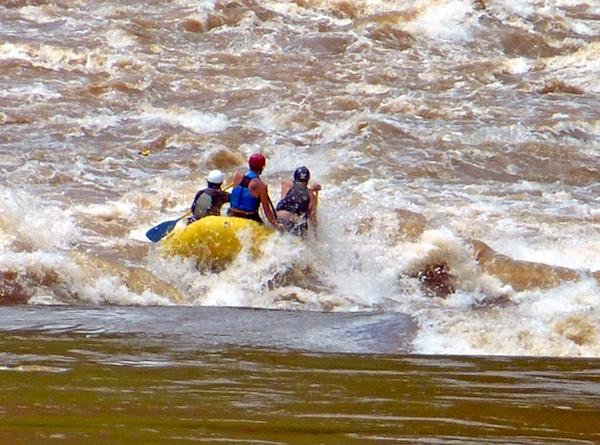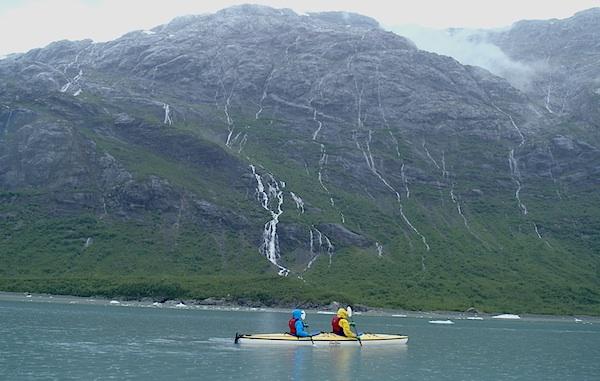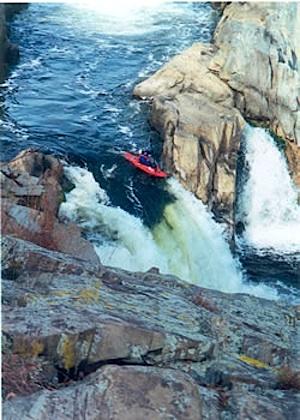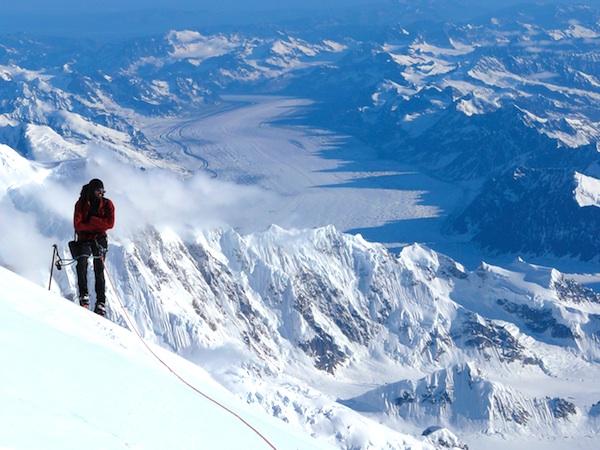
Are these people bored? Fayette Station Rapids, New River Gorge National River/NPS
Did you hear the news?
National parks, those wondrous and scenic expanses of Nature's eye candy, those wild and rumpled landscapes that test your skills and will kill you if you're not careful and prepared, or maybe just in the wrong place at the wrong time, are boring. They've been transformed -- or, perhaps, kept since their creation -- as "drive-through museums."
How did this happen with the National Park Service on watch for the past 98 years?
Apparently because the parks, the Western landscape parks, at least, are managed primarily to protect and preserve their landscapes, not as testing grounds for the latest recreational fad. They are, as Park Service Director Jon Jarvis told us back in March, losing their relevancy with the American public.
'There's a real relevancy problem with the parks,' Adam Cramer, the executive director of the Outdoor Alliance, told a writer from Outside Magazine. 'They're shutting off vectors like bikes and kayaks for people to have the kinds of meaningful experiences that are the genesis for a conservation ethic.'
Really?
Paddlers have been having "meaningful experiences" in the national parks for generations. In our Essential Guide To Paddling The Parks we list more than 90 units of the National Park System that welcome paddlers. They measure themselves (and have meaningful experiences) against the Colorado River through Grand Canyon National Park and Canyonlands National Park, down the Green and Yampa in Dinosaur National Monument, and against the Alaskan rivers that flow through Wrangell-St. Elias National Park and Preserve, Gates of the Arctic National Park and Preserve, and Noatak National Preserve, just to name some of the possibilities.

It takes a good deal of effort, and lust for adventure, to kayak the far end of Glacier Bay in its namesake national park/Kurt Repanshek
Sea kayakers tour the lakes of Yellowstone, Voyageurs, and Acadia national parks, lose themselves for days and even weeks in the waters of Glacier Bay National Park and Preserve, explore the sea-like waters of Lake Superior in Apostle Islands and Pictured Rocks national lakeshores, and venture out into the watery landscapes of Cape Lookout National Seashore, Everglades National Park, and even Glen Canyon National Recreation Area (Lake Powell). Do they go in search of boredom?

Kayaking the Potomac River at Great Falls Park. Boring? No. Crazy? Perhaps/NPS
White-water kayakers can choose from among the New River Gorge National River in West Virginia, the Gauley River National Recreation Area, also in West Virginia, Big South Fork River and Recreation Area in Tennessee, as well as the parks through which the Green and Colorado rivers run. There is no shortage of opportunities. There's even one in Washington, D.C.'s backyard, the Potomic River that roars through Great Falls Park.
Consider the climbing possibilities in places such as Denali National Park, Mount Rainier National Park, North Cascades National Park, Grand Teton National Park, Rocky Mountain National Park, and even on the cliffs of Acadia, and swallowing this "boring" concept gets tougher and tougher.
Really, the issue is not that the parks are "boring." Rather, the Outside article bemoans that they're not flung open to all recreational comers. But then, they weren't intended to be larger manifestations of your local city park.

This Denali climber doesn't look bored/NPS
There's not a "relevancy problem" with the national parks, at least not when it comes to outdoors recreation. If you're bored with the opportunities in the national parks, you're not realizing the possibilities.
Set off, as Andrew Skurka did in 2010, on a 4,679-mile circumnavigation of Alaska on skis, packable raft, and hiking boots, and you won't be bored. You'll be challenged to stay alive in one of the most glorious and demanding settings in North America. Hike the 2,650-mile Pacific Crest Trail as blind hiker Trevor Thomas did, or the 2,184-mile Appalachian National Scenic Trail as Jennifer Pharr Davis did in record-setting time, in one five- or six-month bite and you'll be transformed, physically as well as mentally. You'll likely reorder your life. Discover, as two cavers did in Carlsbad Caverns National Park last Halloween, the largest subterranean room found there in decades, and you won't stop talking about it for a good while.
Are those the types of folks who are being "ostracized," as Grayson Schaffer put it?
In his article in Outside, Mr. Schaffer would have us believe that we need professional bike races through places such as Colorado National Monument, marathons run through Death Valley National Park, and to be able to launch ourselves, cloaked in a wingsuit, off El Capitan at Yosemite National Park to appreciate, savor, and enjoy national parks. Does base-jumping, an inherently dangerous endeavor that has killed two in Zion National Park in Utah this year already, nurture a conservation ethic...or fuel an adrenalin kick, one with a high-risk downside?
How does any of that develop a conservation ethic? Such an ethic is achieved through soaking in the mountains, forests, rivers, lakes, and glaciers, appreciating them for their very existence, and seeking ways to conserve them.
The fallacy of Mr. Schaffer's argument can even be found elsewhere in Outside. In March 2012 the publication ran a story about "12 National Park Adventures Off the Beaten Path." It pointed to:
* river kayaking in Olympic National Park;
* pedaling over the Going-to-the-Sun Road in Glacier National Park and continuing on to Waterton Lakes National Park in Alberta, Canada;
* sea kayaking (with fresh lobster for dinner) at Acadia National Park;
* sea kayaking among the whales and icebergs in Glacier Bay National Park, (where you might share your camps with brown bears);
* climbing among the boulders and outcrops of Joshua Tree National Park;
* climbing to the 13,770-foot summit of the Grand Teton in its namesake park;
* hoisting a pack on your back and hiking for five days through Isle Royale National Park with hopes of catching a wolf's howl;
* or mountain biking in places such as Mammoth Cave National Park in Kentucky, Santa Monica Mountains National Recreation Area in California, Big South Fork River and Recreation Area in Tennessee, or New River Gorge National River in West Virginia.
And there was nary a mention of boredom or lack of opportunities.
That same year, Outside ran an article by Michael Lanza, an occasional contributor to the Traveler, on "The 10 Best National Park Adventures With Kids," and there were no mountain bikes or wingsuits necessary, (although hiking boots, sea kayaks, cross-country skis, and backpacks were).
Finally, we have to wonder what point Mr. Grayson was trying to make when he wrote:
The nonprofit Outdoor Alliance, a Washington, D.C., umbrella group for human-powered-advocacy organizations like American Whitewater, climbing's Access Fund, and the International Mountain Bicycling Association (IMBA), has 100,000 members and skews toward a Gen Y demographic. By comparison, the National Parks Conservation Association (NPCA), the historical champion of the national parks, has 500,000 members with a median age in the sixties.
Is he stereotyping older folks as sedentary folks? Surely that can't be the case, can it? I know and encounter plenty of folks in their sixties and older out enjoying the parks in active recreational pursuits. Indeed, one friend in her 70s rows her own raft down the Yampa and Green rivers through Class III and IV rapids in Dinosaur National Monument, and another still climbs mountains. There are other examples, but the point is that entering one's seventh decade doesn't automatically equate with avoiding the outdoors and retiring to the couch.
The national parks were meant for testing our physical skills, yes, but that basic skill still is walking. Hiking, climbing, cross-country skiing, and paddling are part of walking. Those activities say look at the wilderness, not look at me. Extreme sports are the epitome of 'look at me. Look what I can do!" Fine, put that in an arena, not in a national park. Give it an X Games channel. If Outside Magazine wishes to be Sports Illustrated, tell us now when we may expect the swimsuit issue. But don't call that loving the national parks.
Unfortunately, the blame lies chiefly with the National Park Service and its government narcissists, who, too, have lost their sense of history. As Peggy Noonan writes in The Wall Street Journal, government has simply 'gone too far.' Government has listened to everyone except the people it should be listening to, and sadly, that also goes for our national parks.



Comments
Turn the parks into their own private playgrounds? Which side of the fence are you on now, Wilson. You just described Blackberry Farms and the Smokies which you so feverishly defended and promised to investigate. Flip flop, flip flop.
Benzar is right. Jarvis is whoring out the national parks and in the Smokies it is in the form of private guide services and the Blackberry farm ilk. Well said, Kitty.
And your ilk just wants to turn the Parks into their own private playgrounds. So of course, my ilk, isn't going to agree with your ilk.
As i've stated, and you have little comprehension reading. National Parks are not National Forests or BLM lands. They come with stricter rules, and regulations to attempt to protect park resources well beyond the "me generation" that you are very much a part of, and those kayakers can spend LIFETIMES attempting to paddle all of those available rivers here in the lower 48 and not even get close to paddling them all.
IF grizzly populations are going to be affected by numerous kayakers going down a river, then yes, protecting grizzlies should be a higher priority than protecting the rights of humans trying to paddle. There are thousands of miles of river in this country where grizzlies aren't roaming.
Plus, why can't people be happy paddling in Lake Yellowstone etc? It's allowed there. It's allowed on Shoshone Lake, and on Lewis Lake I don't get your mentality. You want it all, without considering anything beyond your own ego. You seem to not care about National Parks, so why are you here?
I like peak bagging, but I respect the grizzly management zones in the gallitans during times when they are feasting on moths. At that time of season, no one can trudge to the tops of these peaks, and it's in place to protect the Grizzly populations. If we want grizzlies, then me and thousands of others trudging up a mountain where grizzlies eat moths is going to have an adverse effect on them by creating human/grizzly conflicts. Then they will either abandon their wild food source that they need, or fend their territory from humans. They are already pushed to these islands. Where else do they have to go, but to extinction here in the lower 48, because humans like you think we should do what we want, when we want, and without any rules. Yet, millions come to Yellowstone, with the goal of seeing grizzlies. So something has to give. Either the grizzlies habitat, or human ego.
Blackberry farms owns property bordering a national park. They can do what they want on their property. Actually, since you illegally trespassed on their land on one of your ego trips and admitted to it on a blog, I think they could techincally bill you at least a nights stay for using thier property without permission. But hey, i'd be courteous enough to ask for permission before truding onto their property. You on the otherhand just don't get the concept of private and public lands. You think it's all the same.
I certainly don't think the National Parks are boring. Especially when you can pay $770 bucks a night to ride four wheelers where no one has ever been allowed to ride in a national park and chain saw trees on that joyride. There is no price tag on that kind of blackberry fun.
Actually, that would be illegal activity, and jail time and/or fines would be handed down in that case. I believe you might be referring to a one time S&R incident, and thats a different animal, and since the many National Park lands are not established wilderness protected by the wilderness act, technically during S&Rs they could use ATV's or park service vehicles in those operations. But hey, i'm sure you inquired about that before jumping to conclusions, since you are such a logical and well grounded thinker.
There was no jail time handed down at all in that particular incident Gary. Because when you own a high dollar resort and have Senator Lamar Alexander in your back pocket, the Smokies is your private playground and you do as you please. If you would like to do a freedom of information act request you can see the reports of different individuals who reported that particular incident. Nothing happened and nothing will because rich folks do as they please in the Smokies and elsewhere. Just ask Ranger Danno. But that may require you to read something. And we know how you are with follow up on fact finding.
Because it was an S&R incident! Do you understand what that is? Your claims of 4 wheelers using the old hurricane mountain manway that was built by the CCC is absurd and just fearmongering propaganda. You know it, and I know it. You might be able to dupe the clueless on your claims, but you aren't going to pull wool over my eyes pal. I'm in the park way more than you.
Now, enough with hijacking this thread.. This thread is not about the Smokies, or your pseudowar that you wish to wage on the NPS. This thread is about National Parks and their relevancy to attract youth by catering to paragliders, kayakers, mountain bikers, snowmobilers, heli-skiers, etc. I think attracting youth to the parks is already fine and dandy. The Smokies recieves over 9 million tourists. Today it was packed with tourists on a very busy day even for a monday. Young adults are in the backcountry, people are on the trails, on the roads, and in the campground enjoying their time. I don't think this park is being forgotten. So what if 4 wheelers, and mountain bikers cant trapese over the AT, or paragliders can't take a flight off peregrine peak to try and parasail to dollywood, or that photographers are not permitted to fly a camera drone to tree mama and her three bears in cades cove to get the shot. That darn pesky NPS trying to maintain some semblance of the ecosystem for the future generations is getting in the way of the tea partiers, some real estate agents, and all the misguided egotists that didn't pay attention to what the mission is of a National Park.
Gary Wilson, I am in agreement with your posts, our National parks (is it still 56 of them) and the nations designated wilderness areas are our most protected public lands. The management of these areas extends beyond just peoples recreational activities, as worthy as they maybe. The ecological value of these areas is enormous and it is the mission of the NPS to to manage them in such a way "and by such means that they remain unimpaired for future generations". I have much respect for the skill, physical fitness and outdoor enthusiasm of the myriad groups of recreational users of public lands. However, the NPS simply cannot maintain its core mission by becoming a mecca for every recreational user. I think the comments attributed to NPS Director Jarvis are mostly political, the Parks are doing OK except for some funding issues which congress refuses to address. Plenty of money for the military/industrial complex that former Republican President Eisenhower warned us about ( more than 50 years ago now), and more tax cuts for the highest income people seem to be the highest priority. Pretty sad state of affairs.